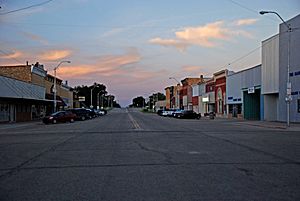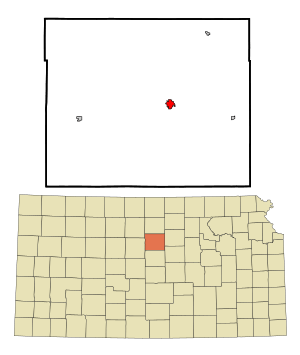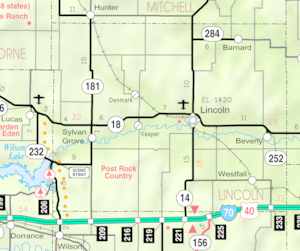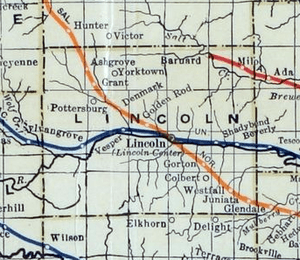Lincoln Center, Kansas facts for kids
Quick facts for kids
Lincoln, Kansas
|
|
|---|---|
|
City and County seat
|
|

Lincoln business district (2010)
|
|

Location within Lincoln County and Kansas
|
|

|
|
| Country | United States |
| State | Kansas |
| County | Lincoln |
| Founded | 1870 |
| Incorporated | 1879 |
| Named for | Abraham Lincoln |
| Government | |
| • Type | Mayor–council |
| Area | |
| • Total | 1.25 sq mi (3.24 km2) |
| • Land | 1.25 sq mi (3.24 km2) |
| • Water | 0.00 sq mi (0.00 km2) |
| Elevation | 1,417 ft (432 m) |
| Population
(2020)
|
|
| • Total | 1,171 |
| • Density | 937/sq mi (361.4/km2) |
| Time zone | UTC-6 (CST) |
| • Summer (DST) | UTC-5 (CDT) |
| ZIP code |
67455
|
| Area code | 785 |
| FIPS code | 20-40800 |
| GNIS ID | 472553 |
Lincoln, also known as Lincoln Center, is a city in Kansas, United States. It's the main town, or county seat, of Lincoln County. In 2020, about 1,171 people lived there.
Contents
History of Lincoln, Kansas
A settler named George Green started the town of Lincoln in 1870. He named it after the county. The word "Center" was added to its name because it was in the middle of the county.
At first, people in the county voted for Lincoln Center to be the county seat (the main town where the government offices are). But in November 1870, another vote moved the county seat to a nearby place called Abram. This started a "county seat war," which was a disagreement over where the main town should be.
In February 1872, people voted again, and Lincoln Center became the county seat once more. All the buildings from Abram were moved to Lincoln, and the two communities joined together. In 1879, the town officially became the city of Lincoln Center. However, the city government and local businesses usually call it Lincoln, and that's how it appears on state maps.
Growth and Modernization
Lincoln grew quickly over the next ten years, more than doubling in size. The city also became more modern. In 1885, Kansas Christian College opened in Lincoln. The Union Pacific Railroad built a train line through the city in 1886, which helped with mail delivery.
In 1900, after the old courthouse burned down, a new one was built. It was made from a special local stone called post rock. Mail delivery to rural areas started in 1904, and phone service began in 1905. In 1906, the city's first power plant opened, bringing electric power to homes and businesses.
Starting in the 1920s, new machines made farming easier, so fewer people were needed for farm work. Also, larger farms started to take over smaller family farms. This caused the population to slowly decrease. By 1950, major roads like K-14 and K-18 were completed through Lincoln.
In 1989, the Kansas Legislature officially called Lincoln County "The Post Rock Capital of Kansas." This was because the local post rock limestone had been used for building for a very long time. In the past, Lincoln even offered free land to encourage people to move there, but this program stopped in 2024.
Geography and Climate
Lincoln is located on the north side of the Saline River. This area is part of the Smoky Hills region within the Great Plains. Yauger Creek flows along the east side of the city and joins the Saline River just south of town. Another creek, Lost Creek, joins the Saline River southwest of the city.
Lincoln is in north-central Kansas, where Kansas Highway 14 (K-14) and Kansas Highway 18 (K-18) meet. It's about 101 miles (163 km) northwest of Wichita and 190 miles (306 km) west of Kansas City.
The city covers about 1.24 square miles (3.21 square kilometers) of land.
Lincoln's Weather
Lincoln has a humid continental climate. This means it has hot, humid summers and cold, dry winters. The hottest temperature ever recorded in Lincoln was 119°F (48°C) on July 13, 1934. The coldest temperature was -27°F (-33°C) on December 23, 1989.
| Climate data for Lincoln, Kansas, 1991–2020 normals, extremes 1912–present | |||||||||||||
|---|---|---|---|---|---|---|---|---|---|---|---|---|---|
| Month | Jan | Feb | Mar | Apr | May | Jun | Jul | Aug | Sep | Oct | Nov | Dec | Year |
| Record high °F (°C) | 81 (27) |
87 (31) |
95 (35) |
104 (40) |
108 (42) |
115 (46) |
119 (48) |
118 (48) |
117 (47) |
103 (39) |
88 (31) |
81 (27) |
119 (48) |
| Mean maximum °F (°C) | 66.0 (18.9) |
71.9 (22.2) |
81.8 (27.7) |
88.2 (31.2) |
93.7 (34.3) |
101.0 (38.3) |
105.4 (40.8) |
103.7 (39.8) |
98.9 (37.2) |
91.6 (33.1) |
77.4 (25.2) |
66.0 (18.9) |
107.0 (41.7) |
| Mean daily maximum °F (°C) | 40.7 (4.8) |
45.3 (7.4) |
56.4 (13.6) |
66.0 (18.9) |
75.7 (24.3) |
87.3 (30.7) |
92.7 (33.7) |
90.1 (32.3) |
82.2 (27.9) |
69.6 (20.9) |
55.0 (12.8) |
42.8 (6.0) |
67.0 (19.4) |
| Daily mean °F (°C) | 28.3 (−2.1) |
32.0 (0.0) |
42.3 (5.7) |
51.9 (11.1) |
62.8 (17.1) |
74.3 (23.5) |
79.5 (26.4) |
76.9 (24.9) |
68.4 (20.2) |
55.2 (12.9) |
41.5 (5.3) |
30.8 (−0.7) |
53.7 (12.0) |
| Mean daily minimum °F (°C) | 16.0 (−8.9) |
18.7 (−7.4) |
28.2 (−2.1) |
37.8 (3.2) |
49.8 (9.9) |
61.4 (16.3) |
66.3 (19.1) |
63.7 (17.6) |
54.7 (12.6) |
40.9 (4.9) |
27.9 (−2.3) |
18.9 (−7.3) |
40.4 (4.6) |
| Mean minimum °F (°C) | −1.8 (−18.8) |
1.6 (−16.9) |
10.4 (−12.0) |
22.2 (−5.4) |
34.5 (1.4) |
48.2 (9.0) |
55.3 (12.9) |
53.8 (12.1) |
38.6 (3.7) |
24.0 (−4.4) |
11.3 (−11.5) |
2.4 (−16.4) |
−5.9 (−21.1) |
| Record low °F (°C) | −26 (−32) |
−24 (−31) |
−19 (−28) |
3 (−16) |
25 (−4) |
35 (2) |
44 (7) |
40 (4) |
26 (−3) |
6 (−14) |
−8 (−22) |
−27 (−33) |
−27 (−33) |
| Average precipitation inches (mm) | 0.71 (18) |
1.03 (26) |
1.62 (41) |
2.60 (66) |
4.62 (117) |
3.97 (101) |
4.02 (102) |
3.87 (98) |
2.42 (61) |
1.92 (49) |
1.17 (30) |
1.11 (28) |
29.06 (737) |
| Average snowfall inches (cm) | 4.3 (11) |
3.9 (9.9) |
1.5 (3.8) |
0.9 (2.3) |
0.0 (0.0) |
0.0 (0.0) |
0.0 (0.0) |
0.0 (0.0) |
0.0 (0.0) |
0.2 (0.51) |
1.6 (4.1) |
2.9 (7.4) |
15.3 (39.01) |
| Average precipitation days (≥ 0.01 in) | 3.9 | 4.6 | 6.1 | 7.8 | 10.4 | 9.1 | 8.6 | 8.2 | 6.7 | 5.8 | 4.7 | 4.2 | 80.1 |
| Average snowy days (≥ 0.1 in) | 2.2 | 2.0 | 1.0 | 0.4 | 0.0 | 0.0 | 0.0 | 0.0 | 0.0 | 0.2 | 0.7 | 1.9 | 8.4 |
| Source 1: NOAA | |||||||||||||
| Source 2: National Weather Service | |||||||||||||
People of Lincoln
| Historical population | |||
|---|---|---|---|
| Census | Pop. | %± | |
| 1880 | 422 | — | |
| 1890 | 1,100 | 160.7% | |
| 1900 | 1,262 | 14.7% | |
| 1910 | 1,508 | 19.5% | |
| 1920 | 1,613 | 7.0% | |
| 1930 | 1,732 | 7.4% | |
| 1940 | 1,761 | 1.7% | |
| 1950 | 1,636 | −7.1% | |
| 1960 | 1,717 | 5.0% | |
| 1970 | 1,582 | −7.9% | |
| 1980 | 1,599 | 1.1% | |
| 1990 | 1,381 | −13.6% | |
| 2000 | 1,349 | −2.3% | |
| 2010 | 1,297 | −3.9% | |
| 2020 | 1,171 | −9.7% | |
| U.S. Decennial Census | |||
Population in 2020
The 2020 United States census counted 1,171 people living in Lincoln. There were 522 households and 296 families. Most people (about 90%) were white. A small number were black, Native American, or Asian. About 8.5% of the population was Hispanic or Latino.
About 23.5% of the people were under 18 years old. The average age in Lincoln was 45 years. For every 100 females, there were about 108 males.
Population in 2010
In the 2010 United States Census, there were 1,297 people living in Lincoln. Most residents (96.6%) were White. About 2.8% of the population was Hispanic or Latino.
The average age was 44.9 years. About 25.1% of residents were under 18 years old.
Education in Lincoln
Lincoln has its own public school district, Lincoln USD 298. This district runs two schools in the city:
- Lincoln Elementary School (for students in Pre-Kindergarten to 5th grade)
- Lincoln Junior/Senior High School (for students in 6th to 12th grade)
Transportation and Infrastructure
Lincoln is located just south of where two main Kansas state highways meet:
- K-14 runs north and south through the city.
- K-18 goes around the northern and eastern parts of the city.
The Lincoln Municipal Airport is a small airport for private planes. It's about a mile northwest of the city, near K-18. A train line, part of the Kansas & Oklahoma Railroad, also runs through the west side of Lincoln.
Local Media
Lincoln has one weekly newspaper called The Lincoln Sentinel-Republican.
Famous People from Lincoln
Some notable people who were born or lived in Lincoln include:
- William Baker (1831-1910), who was a U.S. Representative for Kansas.
- Jessa Crispin (born 1978), a book critic.
- Don Wendell Holter (1905-1999), a Methodist bishop.
- Daniel Ray Hull (1890-1964), a landscape architect.
- Martin Johnson (1884-1937), an adventurer, explorer, and documentary filmmaker.
- Jack Knight (1893-1945), a pioneer in aviation.
- Bessie Anderson Stanley (1879-1952), a poet.
- Uncas A. Whitaker (1900-1975), an engineer and entrepreneur.
See also
 In Spanish: Lincoln Center (Kansas) para niños
In Spanish: Lincoln Center (Kansas) para niños



